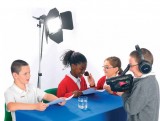Let children run and manage their own TV channel, suggests Jonathan Lear.
How we promote urselves as schools is a vital part of what we do. The reason we share and celebrate our achievements is unashamedly about letting everyone know that our school is a great place to be. Entrance displays, newsletters, the school website or VLE are all geared towards presenting our school in the best possible light – a place of which the children and parents can be proud.
It’s possible, however, that we’re doing too much of the work ourselves. In the examples listed above, the majority are developed and managed by staff in school. Perhaps it’s time to let the people who know best take over the promotional reigns? If our school really is a great place to be there’s no one better than the children to shout it from the roof tops, or in this case, a flat screen TV.
I’ve been to a number of schools recently that have TV screens in either their entrance area, or places where parents or visitors tend to congregate. They generally include information about events in school and photographs of the children taking part in various activities. They definitely stand out, and you find yourself watching them just to see what’s coming next. They are always professionally presented, but rarely, if ever, have any direct input from the children themselves.
This unit aims to address this by creating a school TV channel, staffed, run and managed entirely by the children. Now, before you stop reading, I know that schools with this kind of
TV equipment already installed are in the minority, but this will not prevent the project getting off the ground. I would imagine that some of the ‘official’ information systems I’ve seen are pretty expensive. However, all you really need is a screen that will allow you to show a DVD. If you shop around (particularlyon a website named after a famous South American river), it’s possible to buy a flat screen TV with built in DVD player for under £150. If this is too much of a stretch for the budget, the children could present their case to the school council, or get involved in raising the funds for the purchase themselves. Equally, you might just commandeer a computer to set up in the entrance area that will do exactly the same job.
With the technical side of things in hand, we can get on with the good bits, helping the children become the stars of their very own TV channel.
 The best way to get the project up and running is to work fairly intensively at the beginning. This will allow the children time to get to grips with both the planning and technical aspects involved. The aim of the work is to get to the point where it’s relatively self sustaining. A school TV channel would need to remain fairly current, which requires regular updates. If the children learn the skills needed from the outset, it’s conceivable that the project could run throughout the year as a lunchtime or after school club with very little adult intervention. When introducing the concept to the children, it’s likely that you’ll be swamped under a deluge of ideas. In order for these to be refined, it would be a good idea to consider what is already occurring. As a school, how do we currently celebrate our successes? What kind of information do we share with our parents and community? If we could tell people about our brilliant school, what would we say? How could we share the good work that we’re doing?
The best way to get the project up and running is to work fairly intensively at the beginning. This will allow the children time to get to grips with both the planning and technical aspects involved. The aim of the work is to get to the point where it’s relatively self sustaining. A school TV channel would need to remain fairly current, which requires regular updates. If the children learn the skills needed from the outset, it’s conceivable that the project could run throughout the year as a lunchtime or after school club with very little adult intervention. When introducing the concept to the children, it’s likely that you’ll be swamped under a deluge of ideas. In order for these to be refined, it would be a good idea to consider what is already occurring. As a school, how do we currently celebrate our successes? What kind of information do we share with our parents and community? If we could tell people about our brilliant school, what would we say? How could we share the good work that we’re doing?
Show the children different news clips that illustrate how good news might be shared. Allow the children to discuss how this format might be adapted to our own TV channel. One possibility is that presenters, or news readers, are used to link different sections together. With a basic structure decided upon, the children can then work on the ideas for the different aspects of the channel (see ‘What’s On’ for examples).
The majority of the sections will be filmed by the children. Most schools will have this equipment to hand; the children will need help with the basics but it won’t take long before they are ready to go. In terms of uploading and editing their work, Windows Movie Maker offers enough basic functions to put together a really great looking film which can then be burned to DVD.
The main challenge with this project will be to manage the children’s ideas. In everything that they do, they must not lose sight of the fact they are presenting the very best of the school to a wide range of people. In terms of the project continuing, it may be wise to set up a pupil based quality control board. Any ideas and film clips submitted would have to be passed by the group before being added to the DVD. In this process, any issues with unsuitability or poor quality can be rooted out.
In taking on a project like this, there’s a huge amount of responsibility that’s passed on to the children. In my experience, they rarely fail to rise to the challenge, and love the opportunity to work on something with a real purpose. The only real problem you might have will be getting rid of the crowds of parents whoare glued to the show!
 In addition to ideas that the children will generate, here are some features that could stem from specific bits of learning…
In addition to ideas that the children will generate, here are some features that could stem from specific bits of learning…
One of my favourite contexts for persuasive writing is based around shopping channels like QVC or Price Drop TV. Groups of children could film themselves ‘selling’ uniforms or other school branded products to parents. How would they describe a school book bag so that parents were desperate to get their hands on one?
Roving reporters might cover different events in school. Members of staff and children could be interviewed for the channel giving first hand reactions.
Another feature might be a ‘headteacher’s half a minute’ section. Children could give the head 30 seconds to record a message to parents about upcoming events or to recount something great they’ve seen in school that week.
‘Getting to know you’ could feature as an opportunity for parents to get to know members of staff. The children could write a set of light hearted question prompts that they would film staff answering; ‘What’s your favourite chocolate bar?’ ‘Who’s your favourite cartoon character?’ Maybe they could ask questions where the interviewee chooses a preference e.g. Tea or coffee? Countryside or city? Superman or Spiderman? something with a real purpose.
Jonathan Lear is a Teaching Award winner and AST at St Catherine’s Catholic Primary School, Sheffield. Find more articles from Jonathan on our website, teachprimary.com/resources
Kindness is contagious - give your colleagues a boost by recognising their efforts
Ace-Classroom-Support
Pie Corbett’s bike poems
Topic
5 friendship and emotions intervention ideas
Ace-Classroom-Support
